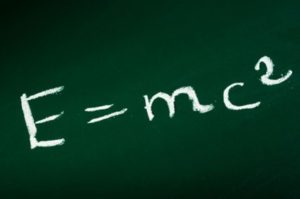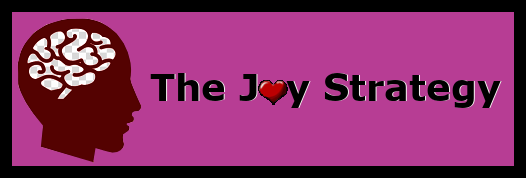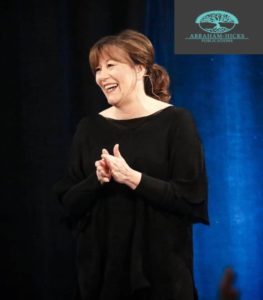Synergy - the bonus that is achieved when things work together harmoniously.
— Mark Twain
Welcome to The Joy Strategy, where our goal is to use the universal Law of Attraction to prioritize our daily Joy.
Before we go any further, a few critical shout-outs are in order.
GET CAUGHT UP!
If you haven’t already, please click to read the prior posts in this series:

You might not be a scientist, but you probably recognize that famous equation.
Nobel Prize winning physicist Albert Einstein came up with it in 1905 when he figured out that energy and mass (matter) are interchangeable.
After some brilliant fine-tuning and reduction, Albert simplified his discovery to this:
Energy equals mass times the speed of light squared.
E=MC2
Discoveries like Einstein’s equation involve combining prior discoveries.
To figure out that E=MC2, first Einstein had to understand all the prior discoveries others made about mass and the speed of light and mathematics, plus scores of other discoveries that geniuses before him had already figured out. Then Einstein used his own brilliance to combine those worlds into something new.
That’s true of a lot of useful discoveries we modern humans enjoy.
Couldn’t have ‘discovered’ automobiles without combining the prior discoveries of cloth and iron and wheels and gas-powered engines and lots of others.
Couldn’t have ‘discovered’ cell phones without combining the prior discoveries of landlines and computers and cellular transmission and micro-technology and plastic and more.
Same goes for this Joy Strategy.

Couldn’t have ‘discovered’ the Joy Strategy in this book without combining the prior discoveries of at least three major sources:
- The ‘Dead People’ I already mentioned
- Nichiren Buddhism
- Authors like M. Scott Peck, Eckhart Tolle, Elizabeth Gilbert and others
Before I break down the Joy Strategy that’s been ‘discovered,’ I want to give a heartfelt shout out (with links) to all the prior discoveries that made this book even possible.
These three sources go far deeper into their respective worlds than I ever could, of course. Their takes are mind-blowing and life-changing. I highly recommend you follow the links I’ve provided and begin your own journey with each of them. Your world, for the better, will never be the same.
I want to give a quick breakdown of how discoveries I learned from each of these sources play a fundamental part of the Joy Strategy.
First, a shout out to the aforementioned Dead People.
The ‘Dead People’
Wait, Zombies are involved???
Nah.
Ever heard of the book or movie called The Secret?
It’s written by Rhonda Byrne and based on that Law of Attraction I already mentioned, a concept that she says is responsible for “the current paradigm shift in consciousness.”
Simply put, through this “law of attraction” you “manifest” your desires.
“It is exactly like placing an order from a catalogue,” says Byrne.
Put even simpler, the universe gives you more of whatever you focus on.
Now, cut-to an entirely different woman named Esther Hicks.
Years ago, Hicks discovered she possesses a unique ability.
Check this out.
Ms. Hicks is able to function as the go-between voice for a group of souls or spirits or energies from the other side. They communicate through Esther to help us humans understand the true purpose of life and death a little more clearly while we’re still here.
This group from the other side calls themselves Abraham.
Together, with Esther, they are called Abraham-Hicks.
Through Esther, Abraham has described themselves as “a group consciousness from the non-physical dimension.”
They are the energy of Source.
My wife has nicknamed them the “Dead People” because that’s essentially who they are.
Already dead people on the other side, in energy form, taking time out of their busy afterlife to talk to us on this side about the purpose of life and death.
Don’t worry – you don’t have to believe in any of that part to benefit from their wisdom.
For example, one of the main tenets of the Dead People is that “the purpose of your life is joy.”
According to Abraham, that’s why every one of us was born, to pursue true Joy.
The Joy Strategy fully utilizes that tenet – that we are here on earth to experience Joy.
And that we can use the Law of Attraction to get the universe to send us more Joy.
Or more Not-Joy, depending on how we are signaling.
The Joy Strategy is based on the belief that the Dead People’s Joy / Not-Joy concept is true.
And that the Law of Attraction is also true.
Shout out to Esther Hicks, Abraham and Rhonda Byrne.
Without them, there is no Joy Strategy.

Nichiren Buddhism
Wait, religion is involved???
Nah.
Just to be clear, Buddhism is not a religion; it’s more of a philosophy and a moral discipline.
And as is true with many philosophies and disciplines, over the centuries various movements have broken out.
One of those movements is based on the teachings of Nichiren Daishonin (1222-1282), a 13th century Japanese monk.
Nichiren tried to reform Buddhism and Japanese society, basically like a Buddhist Martin Luther.
His teaching was based on the Mahayana sutra (scripture) known as the Lotus Sutra.
The philosophy of the Lotus Sutra and Nichiren Buddhism is simple:
Personal enlightenment can be achieved in one lifetime and is available to everybody.
It also emphasizes the importance of individuals taking responsibility for improving themselves.
With that as their goal, Nichiren Buddhists are known for chanting.
Their mantra is “Nam Myoho Renge Kyo,” pronounced “Nah-Moo” “Mee-Yoh” “Hoe” “Wren-Gay” “Kee-Yoh.”
Roughly translated, it means, “Devotion to the Mystic Law of Cause and Effect through vibration.”
Nichiren Buddhism teaches that the law of cause and effect underlies the workings of all phenomena.
The Law of Cause and Effect states:
Positive thoughts, words, and actions create positive effects in the lives of individuals, leading to happiness.
Negative thoughts, words, and actions on the other hand—those that in some way undermine the dignity of life—lead to unhappiness.
This is also the general principle of what is referred to as ‘karma.’
And interestingly enough, it’s almost the same concept as the Law of Attraction.
Meaning, they both essentially tell us that the universe gives you more of whatever you focus on.
The ‘discovery’ of the Joy Strategy is based on the idea that personal enlightenment, seeking Joy, can be achieved in one lifetime and is available to everybody.
And also that it is important for individuals to take responsibility for improving themselves and seek out their own happiness and Joy, which spreads to others.
Shout out to Nichiren and the Lotus Sutra for figuring all that out a long, long time ago.

Scott Peck, Eckhart Tolle, Elizabeth Gilbert and Others
Wait, self-help gurus are involved???
Yup. But in a good way.
Some of the major philosophies that the Joy Strategy is based on come from discoveries I learned from authors M. Scott Peck, Eckhart Tolle and Elizabeth Gilbert.
Dr. Morgan Scott Peck was an American psychiatrist and best-selling author who wrote The Road Less Traveled, published in 1978.
Among many things Peck reminds us of in Road Less Traveled is the first Noble Truth, which states that life involves suffering. Peck noticed that most of us look at struggles as “unexpected interruptions” instead of the “inevitable daily hiccups” that they are.
Peck also teaches his idea that “delayed gratification”’ is fundamental to a happy life.
Peck says, “Until you value yourself, you won’t value your time. Until you value your time, you will not do anything with it.”
He recommends doing your work first, then getting to your play afterwards for full enjoyment.
Shout out to M. Scott Peck for reminding us that life is inherently difficult and Not-Joy can be expected, which isn’t personal, and of the principle of delayed gratification.
Without these key concepts, the Joy Strategy would never have been ‘discovered.’
Eckhart Tolle, pronounced “ek” “hard” “toLLee,” has written many bestsellers.
Among them is The Power of Now: A Guide to Spiritual Enlightenment
It’s a guide for day-to-day living that stresses the importance of living in the present moment and transcending thoughts of the past or future.
Tolle writes: “Pain can only feed on pain. Pain cannot feed on joy. It finds it quite indigestible.”
Also from Tolle: “You cannot find yourself by going into the past. You can find yourself by coming into the present. Life is now.”
In the book, Tolle basically calls out our mental self-talk, our chatty human brains.
He gives us permission to ignore and silence all the voices that are constantly chatting in our minds every day, ghosts that do nothing but pull us constantly away from the present moment.
He’s referring to that mental ‘soap opera’ that drones on and on in our heads.
Tolle tells us that the soap opera isn’t necessary, that it serves no useful purpose.
The Joy Strategy relies on that discovery, so shout out to Eckhart.
Elizabeth Gilbert is the author of the bestseller Eat, Pray, Love, a book which “touched the world and changed countless lives, inspiring and empowering millions of readers to search for their own best selves.”
Problem was, Ms. Gilbert the writer says she got in her head about following up such a big hit, thinking that nothing she could come up with could ever top that.
In her Ted Talk called Your Elusive Creative Genius, Ms. Gilbert beautifully describes the process she discovered for joyful (and stress free) creating. It involves removing the responsibility for thinking of brilliant ideas from the human brain and handing that part over to what she calls “your genius in the wall.” The genius being a higher power of creativity that exists unseen in the universe and is accessible to us all.
Part of the Joy Strategy leans heavily on Ms. Gilbert’s discovery of working with your universal genius to joyfully create, so a big shout out to her for sharing such a brilliant take.
And finally...

The Joy Strategy was created by combining the discoveries of these major sources and more and running with it, so in that sense, this book has an unapologetic element of fan non-fiction to it.
I have thrown these known brilliant philosophical concepts and others into my metaphoric blender and now I’m writing about the smoothie that got made from all those tasty ingredients.
You know, kinda like Albert did but without all that math.
Einstein borrowed mass and speed of light for his first major smoothie, and I’m borrowing Joy, Not-Joy, the Law of Attraction, Cause and Effect and the Genius in the Wall for mine.
Just wanted to be clear about that so I don’t Peggy Hill* any of those discoveries as my own.
Plus, hopefully anyone who might not know about these critical concepts already will get a small head start in understanding them and then click the links I’ve provided to discover more.
Creating your own Joy Strategy costs you absolutely nothing.
Understanding all these concepts well enough to do that only costs you the price of this book.
Hopefully the Joy you begin to discover from it offsets that.
Now let’s talk about Joy / Not-Joy.
Next, we’ll break down all our emotions into two basic categories – Joy and Not-Joy.
See you then.
Mike
*Peggy Hill is the wife of Hank Hill from Mike Judge’s cartoon King of the Hill. Peggy tends to take credit for things that others have already figured out, saying stuff like, “In MY opinion, the day before Thanksgiving is the busiest travel day of the year.”

![You are currently viewing JOY STRATEGY [5]: Three Critical Shout Outs](https://mike-lukas.com/wp-content/uploads/2021/06/shout-outs.jpg)


![Read more about the article JOY STRATEGY [7]: Why the Law of Attraction is Unlike the Law of Gravity](https://mike-lukas.com/wp-content/uploads/2021/06/Gravity-1-300x223.jpg)
![Read more about the article JOY STRATEGY [4]: How to Use the Law of Attraction to Your Advantage](https://mike-lukas.com/wp-content/uploads/2025/01/colorado-trail-image-2-300x200.png)
![Read more about the article JOY STRATEGY [8]: Reaction vs Response](https://mike-lukas.com/wp-content/uploads/2021/08/reaction-vs-response-1-300x233.jpg)